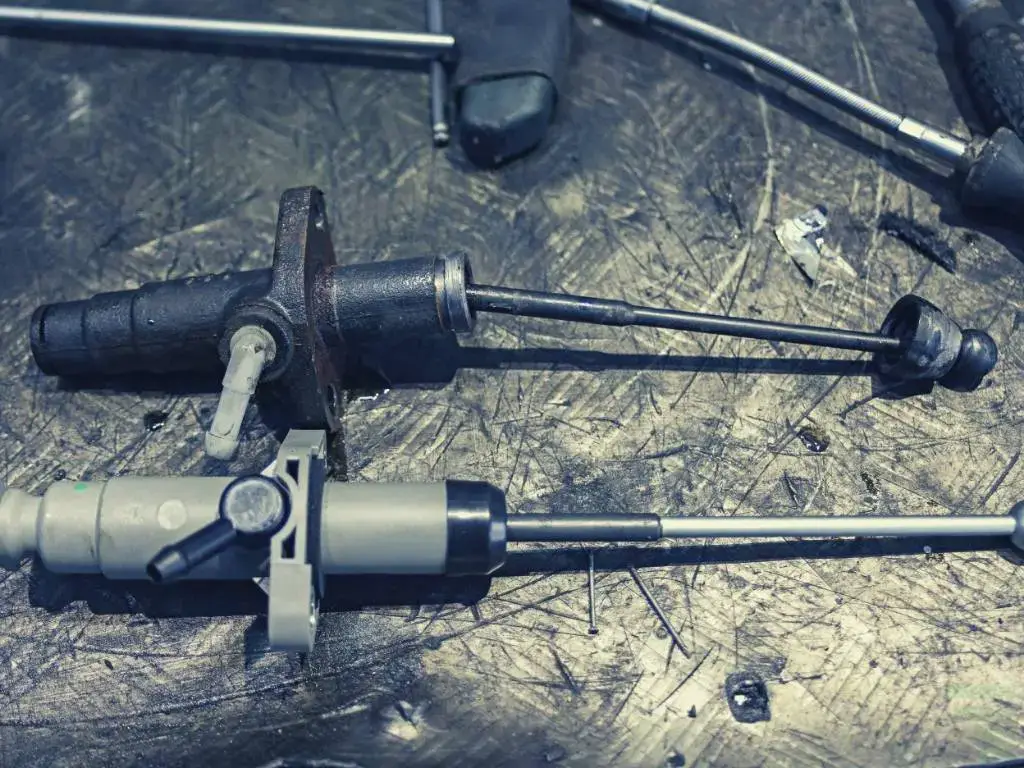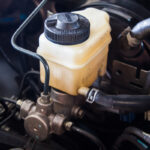The clutch system plays a crucial role in the operation of manual transmission vehicles, providing a seamless connection between the engine and the transmission. Within this system, the slave cylinder, a key component, assists in transferring the hydraulic pressure from the clutch pedal to engage and disengage the clutch.
However, like any mechanical part, the slave cylinder is prone to wear and tear over time, leading to potential issues that can disrupt the smooth functioning of the clutch.
In this article, we will explore the symptoms associated with a bad slave cylinder and delve into the importance of promptly identifying and addressing clutch problems. By understanding these signs and taking appropriate action, you can prevent further damage to your clutch system, ensure optimal vehicle performance, and potentially save on costly repairs.
So, whether you are a seasoned driver or a novice, join us as we discuss the telltale signs of a failing slave cylinder, the potential implications of neglecting the issue, and the steps you can take to address clutch problems effectively. This knowledge will empower you to recognize and resolve slave cylinder-related symptoms, promoting a safer and more enjoyable driving experience.
Table of Contents
What is a Slave Cylinder?
A slave cylinder is a critical component of the hydraulic clutch system in vehicles with manual transmissions. It works in conjunction with the clutch master cylinder to facilitate the engagement and disengagement of the clutch.
Located near the transmission, the slave cylinder is typically mounted on or near the clutch housing. It is connected to the clutch release fork through a pushrod or hydraulic line. When the driver presses the clutch pedal, hydraulic pressure is generated in the clutch master cylinder, then transmitted to the slave cylinder.
The slave cylinder’s primary function is to convert hydraulic pressure into mechanical force. This force is used to actuate the clutch release fork, which in turn disengages or engages the clutch disc. When the clutch is engaged, power from the engine is transferred to the transmission, allowing for the vehicle’s smooth operation.
Slave cylinders are usually sealed units, housing pistons and seals that prevent fluid leaks. Over time, however, the seals can deteriorate or fail, resulting in fluid leaks and a loss of hydraulic pressure. This can lead to clutch-related issues and require the replacement or repair of the slave cylinder.
Get your Clutch slave cylinder replacement on here
Common Symptoms of a Bad Slave Cylinder
A failing slave cylinder can manifest several symptoms that indicate potential issues within the clutch system. Being aware of these signs can help you identify a bad slave cylinder and take appropriate action. Here are the most common symptoms to watch out for:
Difficulty Shifting Gears
One of the primary indications of a failing slave cylinder is difficulty in shifting gears smoothly. You may experience grinding or resistance when engaging or disengaging the clutch. Gear changes may feel rough, and finding the correct gear while driving may become harder.
Soft or Spongy Clutch Pedal
A spongy or soft clutch pedal is another common symptom of a bad slave cylinder. When the slave cylinder is not functioning correctly, it can result in a loss of hydraulic pressure. As a result, the clutch pedal may feel mushy or require more effort to engage. You might notice decreased responsiveness or a delayed engagement when pressing the clutch pedal.
Leaking Fluid
Leaking hydraulic fluid is a clear indicator of a slave cylinder problem. Inspect the area around the slave cylinder for any signs of fluid leakage. The fluid may appear as drips or puddles beneath the vehicle or as wetness around the slave cylinder itself. A loss of fluid can lead to a drop in hydraulic pressure, resulting in clutch malfunctions.
Clutch Slippage
Clutch slippage occurs when the clutch does not engage fully, leading to a loss of power transfer from the engine to the transmission. A failing slave cylinder can contribute to this problem by preventing the clutch from fully disengaging or engaging. As a result, you may experience a lack of acceleration, RPMs increasing without a proportional increase in speed, or a noticeable decrease in overall vehicle performance.
Unresponsive Clutch Pedal
A faulty slave cylinder can make the clutch pedal unresponsive or inconsistent in its operation. You may notice that the pedal feels excessively stiff or fails to return to its normal position after being depressed. This lack of response can be attributed to a lack of hydraulic pressure caused by a malfunctioning slave cylinder.
Clutch Drag
Clutch drag refers to a situation where the clutch does not fully disengage, even when the clutch pedal is fully pressed. This can result in difficulty shifting gears, gear grinding, or a vehicle that feels like it wants to move forward even when the clutch pedal is depressed. A bad slave cylinder can cause inadequate clutch release, leading to clutch drag and related issues.
If you experience any of these symptoms, having your vehicle inspected and repaired by a qualified mechanic is essential. They can diagnose the specific problem, determine if the slave cylinder is at fault, and recommend the appropriate repairs or replacements to restore the clutch system’s proper function.
Addressing a bad slave cylinder promptly is crucial to avoid further damage to the clutch system and ensure a safe and reliable driving experience.
How to Test Clutch Slave Cylinder
When you suspect a bad slave cylinder as the cause of clutch-related issues, there are several steps you can take to diagnose and address the problem. Let’s explore these steps in detail:
Visual Inspection
Start by conducting a visual inspection of the clutch system. Check for any signs of fluid leakage around the slave cylinder or the surrounding area. Look for wetness, drips, or puddles of hydraulic fluid. Additionally, inspect the condition of the clutch pedal and the clutch hydraulic lines for any visible damage or wear. While a visual inspection alone may not provide a definitive diagnosis, it can help identify potential issues and guide your further actions.
Bleeding the Slave Cylinder
If air has entered the clutch hydraulic system, it can cause spongy or unresponsive clutch pedal behavior. Bleeding the slave cylinder is a process that removes air from the system and restores hydraulic pressure. Follow the vehicle manufacturer’s recommended procedure for bleeding the slave cylinder.
Typically, it involves opening the bleeder valve on the slave cylinder while someone else operates the clutch pedal, allowing air and fluid to escape until a solid stream of fluid with no air bubbles is observed. Bleeding the slave cylinder can be a temporary solution if the issue is air-related, but it may not resolve problems stemming from a faulty slave cylinder itself.
Replacing the Slave Cylinder
If the visual inspection or bleeding process confirms that the slave cylinder is faulty, replacement is often necessary. Slave cylinder replacement involves removing the old unit and installing a new one. Consult your vehicle’s service manual or seek professional assistance for guidance specific to your make and model. It is recommended to use a quality replacement slave cylinder and follow proper installation procedures to ensure a reliable repair.
Professional Assistance
If you are unsure about diagnosing or addressing the problem yourself, or if you lack the necessary tools and expertise, it is advisable to seek professional assistance. A qualified mechanic can perform a thorough inspection, accurately diagnose the issue, and carry out the required repairs or replacements. They have the knowledge and experience to handle the complexities of the clutch system and ensure its proper functioning.
Remember, addressing a bad slave cylinder promptly is crucial to prevent further damage to the clutch system and maintain your vehicle’s performance. Whether you choose to diagnose and fix the issue yourself or seek professional help, prioritizing the resolution of a bad slave cylinder will contribute to a smoother and safer driving experience.
Tips for Maintaining a Healthy Clutch System
To ensure the longevity and optimal performance of your clutch system, it is essential to follow some maintenance practices and adopt proper driving techniques.
Regular Maintenance Routines
Incorporate regular maintenance routines into your vehicle care schedule. This includes checking and maintaining proper clutch pedal free play, which ensures the clutch engages and disengages smoothly.
Additionally, inspect the clutch hydraulic fluid reservoir regularly and follow the manufacturer’s recommendations for fluid replacement intervals. Cleanliness and proper adjustment of the clutch linkage and release mechanism are also important aspects of clutch maintenance.
Proper Driving Techniques
Practicing good driving habits can significantly contribute to the health of your clutch system. Avoid riding the clutch pedal, which means keeping your foot off the clutch pedal when it’s not in use. Resting your foot on the pedal can cause unnecessary clutch slippage and wear.
Additionally, avoid aggressive clutch engagement and excessive slipping, especially when starting from a stop or during gear changes. Smooth and deliberate clutch operation, combined with proper gear selection, will help reduce stress on the clutch components.
Monitoring Fluid Levels and Addressing Leaks Promptly
Regularly check the fluid level in the clutch hydraulic reservoir and ensure it is within the recommended range. Low fluid levels can lead to a loss of hydraulic pressure, resulting in clutch-related issues. If you notice any fluid leaks, address them promptly.
Leaking fluid may indicate a failing slave cylinder or other problems within the clutch system. Addressing leaks early can help prevent further damage and maintain the proper functioning of the clutch.
Avoid “Riding” the Clutch
“Riding” the clutch refers to keeping the clutch partially engaged while driving, such as resting your foot on the pedal or keeping the clutch pedal slightly depressed. This practice causes unnecessary wear and overheating of the clutch components. Instead, fully engage the clutch when accelerating and fully disengage it when shifting gears or coming to a stop. Proper clutch usage reduces wear and prolongs the life of the clutch system.
Smooth Gear Changes
Practice smooth and deliberate gear changes by matching engine speed (RPM) to the speed of the vehicle when shifting. Avoid harsh shifting, rapid clutch engagement, or gear grinding. Smooth gear changes reduce stress on the clutch and transmission components, promoting a healthy clutch system.
By incorporating these tips into your driving habits and maintenance routine, you can help maintain a healthy clutch system and prolong its lifespan.
Hydraulic Clutch Slave Cylinder
A hydraulic clutch slave cylinder is a component of the hydraulic clutch system in vehicles with manual transmissions. It works in conjunction with the clutch master cylinder to facilitate the engagement and disengagement of the clutch.
The hydraulic clutch system uses hydraulic fluid, typically brake fluid, to transmit pressure from the clutch pedal to the clutch release mechanism. The clutch master cylinder, located near the clutch pedal, generates hydraulic pressure when the clutch pedal is depressed. This pressure is then transmitted through hydraulic lines to the hydraulic clutch slave cylinder, which is usually mounted on or near the transmission.
The hydraulic clutch slave cylinder contains a piston and seals that convert hydraulic pressure into mechanical force. When the hydraulic pressure is applied, the piston moves, actuating the clutch release mechanism. This action allows for the disengagement of the clutch, enabling smooth gear changes and the transfer of power from the engine to the transmission.
The slave cylinder operates in a closed system, sealed to prevent fluid leaks. However, over time, the seals can wear out or fail, leading to fluid leaks. Leaking hydraulic fluid can result in a loss of hydraulic pressure, causing clutch-related problems such as difficulty shifting gears or a soft clutch pedal.
If a hydraulic clutch slave cylinder becomes faulty or develops leaks, it may need to be replaced or repaired. Professional diagnosis and assistance are recommended to ensure proper maintenance and repair of the hydraulic clutch system.
Clutch Slave Cylinder Price
The price of a clutch slave cylinder can vary depending on several factors, including the vehicle’s make and model, the cylinder’s brand, and where you purchase it. On average, a clutch slave cylinder can range from $50 to $200.
Keep in mind that this price is for the part alone and does not include labor costs if you choose to have it professionally installed. Labor charges can vary depending on the complexity of the job and the rates of the repair shop or mechanic.
It’s worth noting that prices can also vary depending on whether you opt for an original equipment manufacturer (OEM) part or an aftermarket replacement. OEM parts are more expensive but typically of higher quality and specifically designed for your vehicle. On the other hand, aftermarket parts may be more affordable but vary in quality and fit.
To get an accurate estimate for the price of a clutch slave cylinder for your specific vehicle, it’s recommended to consult with a reputable auto parts store, a dealership, or a trusted mechanic. They can provide you with the most accurate pricing information based on your vehicle’s make, model, and year.
Clutch Slave Cylinder vs Master Cylinder
| Clutch Slave Cylinder | Clutch Master Cylinder |
|---|---|
| Location: Typically near the transmission, mounted on or near the clutch housing. | Location: Typically near the clutch pedal inside the vehicle’s engine compartment. |
| Function: Converts hydraulic pressure into mechanical force to actuate the clutch release mechanism. | Function: Generates and stores hydraulic pressure when the clutch pedal is pressed. |
| Hydraulic Pressure: Receives hydraulic pressure from the clutch master cylinder. | Hydraulic Pressure: Provides hydraulic pressure to the clutch slave cylinder. |
| Operation: The piston within the slave cylinder is moved by hydraulic pressure, which pushes or pulls the clutch release fork to engage or disengage the clutch. | Operation: The piston within the master cylinder is activated by the clutch pedal, pushing hydraulic fluid through the clutch hydraulic lines to the slave cylinder. |
| Symptoms of Issues: Difficulty shifting gears, soft or spongy clutch pedal, leaking fluid. | Symptoms of Issues: Loss of hydraulic pressure, spongy or unresponsive clutch pedal, leaking fluid. |
| Repair/Replacement: A faulty or leaking slave cylinder may require replacement or repair. | Repair/Replacement: A faulty or leaking master cylinder may require replacement or repair. |
The clutch slave cylinder and clutch master cylinder are both components of the hydraulic clutch system in manual transmission vehicles. While they work together to facilitate clutch operation, they serve different purposes.
Clutch Slave Cylinder
The clutch slave cylinder is typically located near the transmission, mounted on or near the clutch housing. It is responsible for converting hydraulic pressure into mechanical force to actuate the clutch release mechanism.
When the driver depresses the clutch pedal, hydraulic pressure generated by the clutch master cylinder is transmitted to the slave cylinder. This pressure moves the piston within the slave cylinder, which then pushes or pulls the clutch release fork, engaging or disengaging the clutch.
A faulty or leaking slave cylinder can result in issues such as difficulty shifting gears, a spongy clutch pedal, or clutch slippage.
Clutch Master Cylinder
The clutch master cylinder is typically located near the clutch pedal inside the vehicle’s engine compartment. It is responsible for generating and storing hydraulic pressure when the driver presses the clutch pedal.
When the clutch pedal is depressed, it activates the piston within the master cylinder, which pushes hydraulic fluid through the clutch hydraulic lines to the slave cylinder. The master cylinder ensures that the necessary hydraulic pressure is available to actuate the clutch slave cylinder and engage/disengage the clutch.
If the clutch master cylinder is faulty or develops leaks, it can result in a loss of hydraulic pressure, leading to clutch-related issues.
In summary, the clutch slave cylinder converts hydraulic pressure into mechanical force to actuate the clutch release mechanism near the transmission, while the clutch master cylinder generates and stores hydraulic pressure when the clutch pedal is pressed, supplying that pressure to the slave cylinder. Both cylinders are crucial components of the hydraulic clutch system, and if either of them malfunctions or develops leaks, it can impact the proper operation of the clutch.
Frequently Asked Questions
What is the purpose of a slave cylinder in a clutch system?
The slave cylinder is a component of the hydraulic clutch system. Its purpose is to convert hydraulic pressure from the clutch master cylinder into mechanical force, which actuates the clutch release mechanism. It helps in engaging and disengaging the clutch for smooth gear changes.
Can a bad slave cylinder cause clutch slippage?
Yes, a bad slave cylinder can potentially cause clutch slippage. If the slave cylinder is not functioning properly, it may not fully disengage the clutch, resulting in incomplete power transfer from the engine to the transmission. This can lead to the clutch slipping, causing a loss of power and acceleration.
How long does a slave cylinder typically last?
The lifespan of a slave cylinder can vary depending on various factors, including driving conditions, maintenance, and quality of the component. On average, a slave cylinder can last anywhere from 50,000 to 100,000 miles (80,000 to 160,000 kilometers). However, it’s important to note that premature failure or leaks can occur due to factors such as harsh driving conditions or insufficient maintenance.
Can I drive with a bad slave cylinder?
Driving with a bad slave cylinder is not recommended. A faulty slave cylinder can lead to issues such as difficulty shifting gears, clutch slippage, or an unresponsive clutch pedal. These problems can affect the drivability of the vehicle and may even result in a sudden loss of clutch function. It’s advisable to address the issue promptly to avoid further damage to the clutch system.
Is it possible to repair a faulty slave cylinder, or should it be replaced?
In some cases, it may be possible to repair a faulty slave cylinder, such as by replacing the seals or other damaged components. However, depending on the extent of the damage or wear, it is often more practical and reliable to replace the entire slave cylinder. Consult a qualified mechanic to assess the specific condition of the slave cylinder and determine the best course of action for repair or replacement.
What causes a slave cylinder to leak?
There are several potential causes of a slave cylinder leak. Common reasons include worn or damaged seals within the cylinder, corrosion or damage to the cylinder housing, or improper installation or assembly. In some cases, excessive heat or pressure can also contribute to seal failure and fluid leakage.
How much does it cost to replace a slave cylinder?
The cost of replacing a slave cylinder can vary depending on factors such as the vehicle’s make and model, the cylinder’s brand, and labor costs. The cost of a replacement slave cylinder, excluding labor charges, can range from $50 to $200. Labor costs will vary depending on the complexity of the job and the rates of the repair shop or mechanic.
Are there any DIY methods to fix a bad slave cylinder?
Repairing a bad slave cylinder can be a complex task, and it is generally recommended to seek professional assistance. However, some DIY methods may be attempted, such as replacing seals or cleaning and lubricating the cylinder.
These methods require mechanical knowledge and skills, and success may vary depending on the extent of the damage. It is important to exercise caution and consult appropriate repair manuals or guides before attempting any DIY repairs.
Can a bad slave cylinder affect the transmission?
Yes, a bad slave cylinder can potentially affect the transmission. If the slave cylinder fails to properly engage or disengage the clutch, it can result in difficulty shifting gears, grinding noises during gear changes, or even a complete loss of clutch function. These issues can impact the transmission’s performance and lead to further damage if not addressed promptly.
What are the differences between a hydraulic clutch system and a cable-operated system?
The main difference between a hydraulic clutch system and a cable-operated system lies in how they transmit force to engage and disengage the clutch. In a hydraulic system, hydraulic fluid and pressure are used to actuate the clutch mechanism, with a clutch master cylinder and slave cylinder working together. This system offers smoother and more precise clutch operation but requires regular fluid checks and maintenance.
In contrast, a cable-operated clutch system uses a cable to mechanically pull or release the clutch mechanism when the clutch pedal is depressed or released. These systems are generally simpler and may require less maintenance, but they may lack the precise control and smoothness of a hydraulic system.
The choice between a hydraulic clutch system and a cable-operated system depends on the vehicle’s design and manufacturer’s preferences. Most modern vehicles are equipped with hydraulic clutch systems for their improved performance and ease of use.
In conclusion, the clutch slave cylinder plays a crucial role in the hydraulic clutch system, converting hydraulic pressure into mechanical force to engage and disengage the clutch. Common symptoms of a bad slave cylinder include difficulty shifting gears, a soft or spongy clutch pedal, and fluid leaks. Regular maintenance, proper driving techniques, and prompt addressing of leaks are essential for maintaining a healthy clutch system.
Diagnosing a faulty slave cylinder involves visual inspection, bleeding the cylinder, and potentially replacing it if necessary. Professional assistance is recommended for accurate diagnosis and proper repairs. It’s important to note that driving with a bad slave cylinder is not advisable as it can lead to further clutch-related issues and potentially affect the transmission.
When it comes to maintaining a healthy clutch system, regular maintenance routines, including checking clutch pedal free play and monitoring fluid levels, are crucial. Practicing proper driving techniques, such as avoiding riding the clutch and ensuring smooth gear changes, can also minimize stress on the clutch components.
In terms of cost, the price of a slave cylinder can range from $50 to $200, excluding labor charges for replacement. Repairing a faulty slave cylinder is possible in some cases, but full replacement is often recommended for reliability and performance.
A well-maintained clutch system with a properly functioning slave cylinder is essential for smooth and reliable operation. By following the recommended maintenance practices, driving techniques, and promptly addressing any issues, you can prolong the life of your clutch system and enjoy optimal performance from your vehicle. If you experience any symptoms of a bad slave cylinder or clutch-related problems, it is advisable to seek professional assistance for accurate diagnosis and necessary repairs.
Get your Clutch slave cylinder replacement on here
Reference:
- https://www.carbibles.com/slave-cylinder/
- https://www.autoblog.com/2016/01/05/symptoms-of-a-bad-or-failing-clutch-slave-cylinder/
Hi there! I’m Naomi O’Colman. I’ve got years of experience working at an auto repair shop here in Texas under my belt. On top of that, ever since I was a kid I’ve been passionate about the auto industry. Since I’ve joined the team at automotivegearz.com I’ve been enthusiastically sharing my passion and insights with my readers. I’m dedicated to delivering high quality content and helping you stay up to date with the latest automotive trends and products out there!







